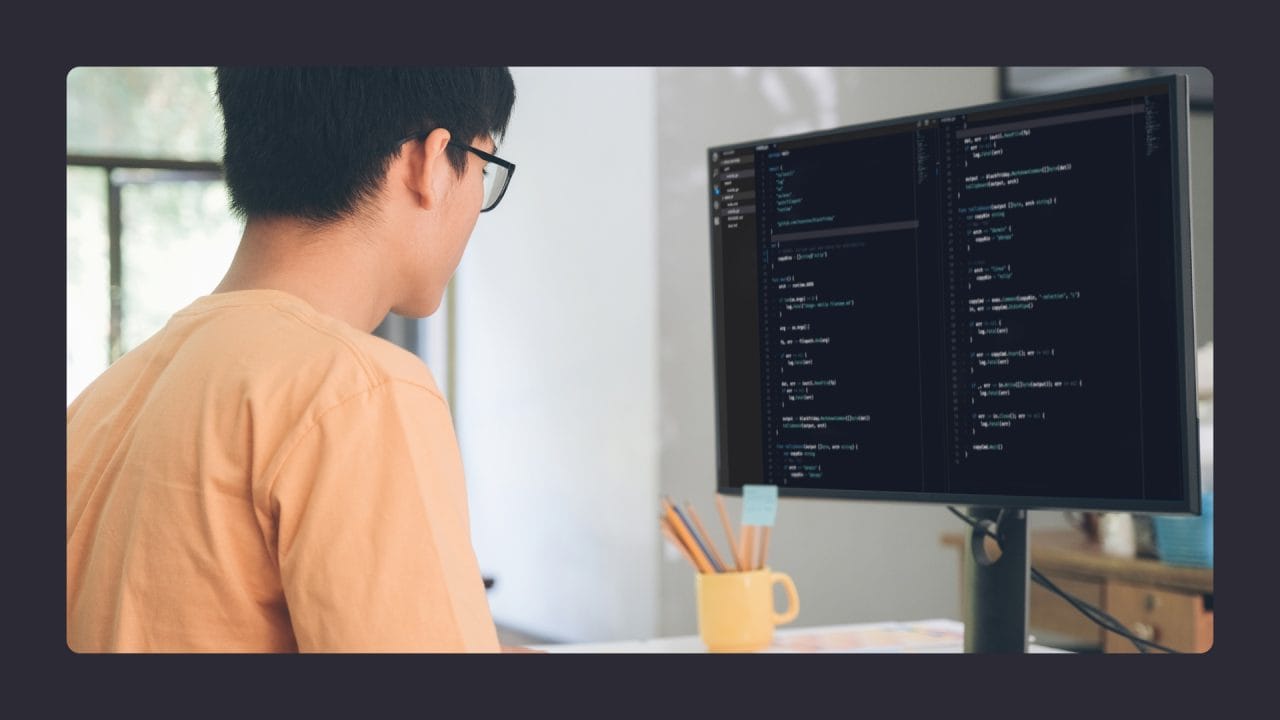
CSS stands for Cascading Style Sheets, a style sheet language used to present documents written in HTML or XML. It is a cornerstone technology, employed by most websites to create visually engaging webpages, user interfaces for web applications, and user interfaces for many mobile applications. CSS enables developers and designers to apply consistent styling across multiple pages of a website without having to write HTML tag attributes repetitively.
Learning CSS is essential for beginners who want to craft appealing websites. It allows for the separation of content from design, giving creators the power to change the entire mood and tone of a webpage without altering the underlying HTML. Through CSS, multiple stylistic changes can be made, from the font type and colour to the layout of elements on the screen.
Beginners will find that mastering CSS selectors and properties is foundational to implementing design visions, creating responsive layouts, and ensuring that websites are accessible across various devices and screen sizes.
Key Takeaways
- CSS is essential for creating visually engaging and consistent web pages: It allows developers to apply styles across multiple pages without repetitive HTML attributes, enabling the separation of content from design. This separation simplifies maintenance and updates, as changes to the CSS file can instantly reflect across the entire website.
- Mastering CSS selectors and properties is foundational for web design: Understanding how to target HTML elements with selectors and apply properties like color, font, and layout is crucial. This knowledge enables the creation of responsive designs that adapt to different screen sizes and devices, enhancing user experience.
- Effective CSS practices include organising stylesheets and using modern techniques: Organising CSS into well-structured stylesheets improves readability and maintainability. Utilising modern CSS features and frameworks can streamline development, allowing for the creation of dynamic, accessible websites that adhere to current web standards.
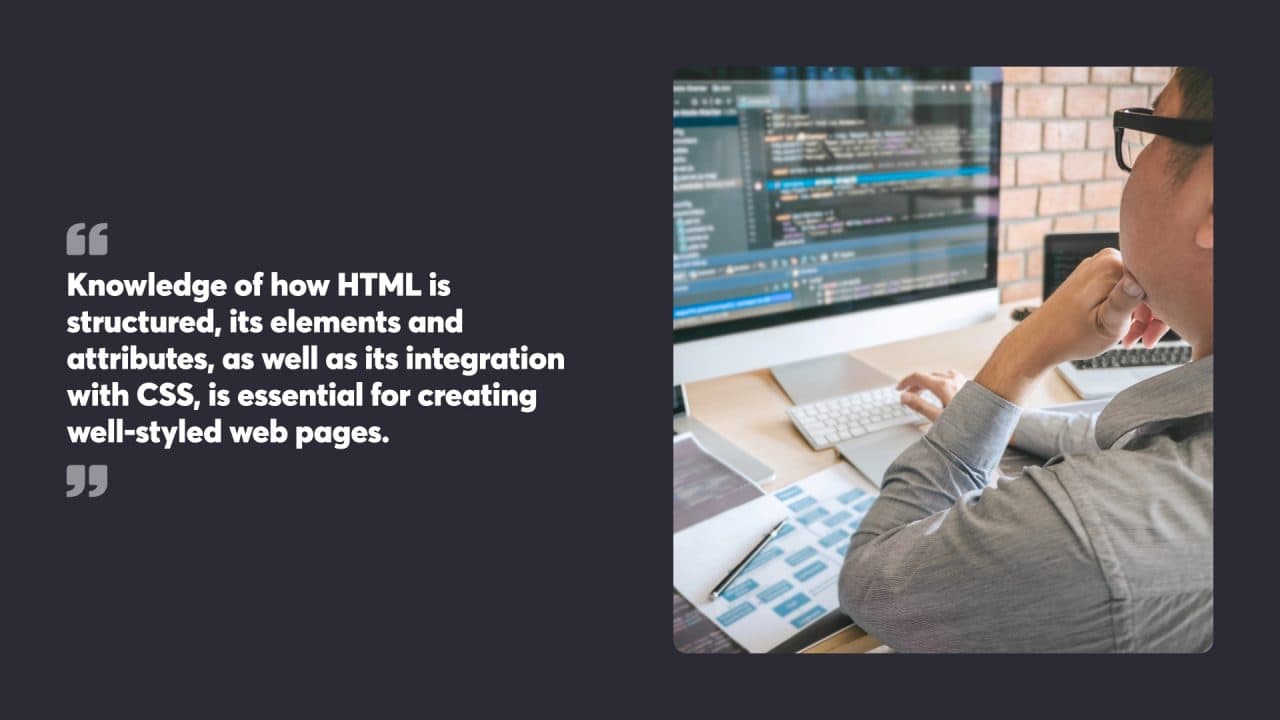
Table of Contents
Understanding the Basics of HTML
HTML is the foundation of web pages, defining their structure and content. HTML code lays out the structure of a web page without defining its appearance, which is where CSS comes in to enhance the visual presentation. Knowledge of how HTML is structured, its elements and attributes, as well as its integration with CSS, is essential for creating well-styled web pages.
Structure of an HTML Document
An HTML document consists of a series of elements forming a nested hierarchy. This structure begins with a <!DOCTYPE html> declaration, followed by the <html> element, containing the <head> and <body> elements. Content is placed within the <body>, whereas the <head> includes metadata and links to CSS.
Linking an external CSS file to an HTML file is essential for styling web pages, and it is done within the <head> section of the HTML file.
Example of a basic HTML document:
<!DOCTYPE html>
<html>
<head>
<title>Title of the document</title>
</head>
<body>
<h1>This is a Heading</h1>
<p>This is a paragraph.</p>
</body>
</html>HTML Elements and Attributes
Elements in HTML are defined by tags, with most having an opening tag <tagname> and a closing tag </tagname>. Attributes provide additional information about elements. Common attributes include id, class, style, and href.
- Bold text is created by
<strong>tag - Italic text is indicated by
<em>tag
Example of an element with attributes:
<a href="https://www.example.com" title="Example">Visit Example.com</a>Including CSS in HTML
CSS styles can be included in HTML documents internally using the <style> tag within the <head>, linked externally via the <link> element, or inline using the style attribute directly on HTML elements. External stylesheets are linked in the <head> section of each HTML page, while internal styles can be defined directly within the <head> section. The inclusion of CSS enhances the visual presentation of HTML pages.
Internal CSS example:
<head>
<style>
body {
background-color: lightgrey;
}
</style>
</head>External CSS example:
<head>
<link rel="stylesheet" type="text/css" href="mystyle.css">
</head>Inline CSS example:
<p style="colour: red;">This is a red paragraph.</p>
Introduction to CSS (Cascading Style Sheets)
This section covers CSS basics, how to craft, and various methods to implement style rules into your HTML.
What CSS Is and How It Works
CSS, or Cascading Style Sheets, serves as the styling language for web documents. Hypertext Markup Language (HTML) is responsible for the structure and content of web pages, while CSS styles those elements, highlighting their distinct yet interdependent nature in web development. It governs how HTML elements present on screens, in print, or in other media. The ‘cascading’ aspect of CSS comes from the way rules follow a specific hierarchy, where some styles will override others depending on their importance or specificity.
CSS Syntax and Structure
A CSS rule consists of a selector and a declaration block. The selector points to the HTML element to style, while the declaration block contains one or more declarations separated by semicolons. Each declaration includes a CSS property name and a value, separated by a colon. CSS comments can be added using /* This is a comment */ syntax, which is essential for maintaining the clarity of the CSS file
Methods to Apply CSS
There are three primary methods to apply CSS to HTML: Inline, Internal, and External.
- Inline CSS adds style directly within an HTML tag using the
styleattribute. - Internal CSS places CSS within a
<style>tag in the HTML document’s<head>section. - External CSS links a separate CSS file to the HTML using a
<link>element, allowing style sheets to be applied consistently across multiple pages.
Understanding both HTML and CSS is crucial for effectively developing and designing web pages, as HTML structures content while CSS styles it.
Implementing CSS effectively organises presentation away from content, which significantly simplifies web development and maintenance.
CSS Selectors Explained
CSS selectors are fundamental to applying styles to HTML elements. They connect the design rules to the elements that need styling within the document.
Element Selector
The element selector targets the HTML elements based on their type. This straightforward approach is applied by simply using the tag name to define styles. For example, styling all <p> tags on a page:
p {
font-size: 16px;
color: blue;
}Class Selector
Class selectors are more specific and versatile than element selectors, allowing styles to be applied to groups of elements across the HTML document. Elements with the same class attribute receive the same styles, marked by a leading period. For instance:
.product {
display: flex;
padding: 10px;
}ID Attribute
An ID selector provides a singular reference to an HTML element with a specific id attribute. It is represented by a hash symbol followed by the id value and defines styles that are exclusive to a single element:
#header {
background-color: grey;
border-bottom: 1px solid black;
}Selecting with the ID attribute is precise, targeting only the element that carries the distinct ID.
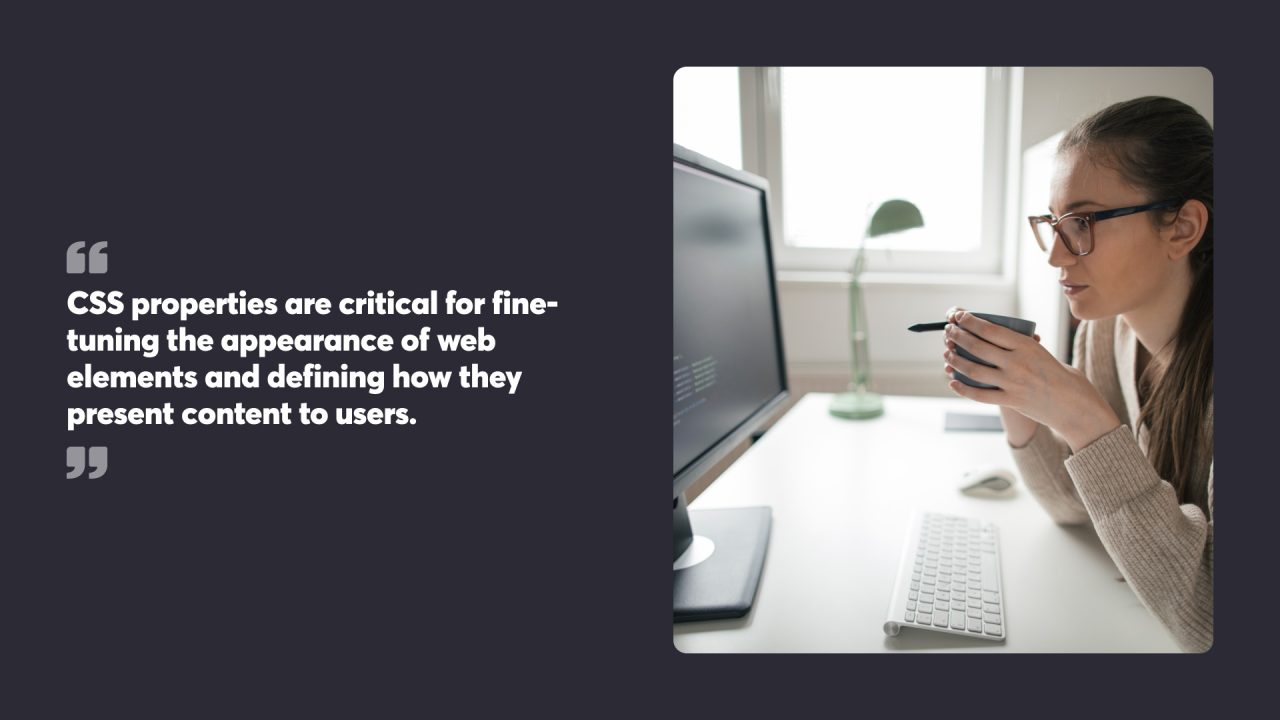
CSS Properties in Depth
CSS properties are critical for fine-tuning the appearance of web elements and defining how they present content to users.
Text Formatting Properties
CSS offers an array of properties to control text formatting. The font-family property specifies the typographic design of a text, allowing developers to apply different font styles. Selecting the correct font family enhances the readability and the aesthetic value of text on a website.
The font size property adjusts the size of the text. It is a foundational aspect of web typography, affecting both aesthetics and usability. Values for font size can be defined in various units such as pixels (px) or relative units like ems and rems.
Font-weight manages the thickness of the characters, ranging from thin to bold. This property contributes to text emphasis and hierarchy within content.
The text-align property aligns text within an element, with options like left, right, centre, or justify, to enhance the structure and layout of text blocks.
Box Model and Layout Properties
The box model is a CSS concept critical for creating layouts. It includes the margin, border, padding, and the content area of each HTML element.
- The margin property controls the space outside the border, affecting how elements are spaced in relation to their surroundings.
- The border property defines the edge of an element, allowing visual separation from other elements.
- The padding property represents the space between the content and the border, influencing the perception of depth and aesthetics.
- Lastly, the content area, determined by properties like width and height, dictates the actual space taken up by the element’s content, such as text or images.
Background related properties modify the appearance behind the content area. Background colour sets the background hue of an element, whereas the background image property allows for more visual complexity by placing an image behind the content.
Visual Styling Properties
Properties in this category affect the visual impact of elements beyond basic text and layout. Background colour and background image allow for diverse visual effects, enabling the creation of rich and engaging backgrounds.
Borders, shadows, and overlays contribute to dimension and depth, providing subtle cues about an element’s function or importance. For example, border-radius adds rounded corners, softening the overall feel of the design and potentially enhancing the user’s interactive experience.
Opacity and gradients are tools within the visual styling kit, offering designers the capability to craft interfaces that are both functional and visually captivating. CSS properties thus serve as essential components in sculpting user interfaces that are not just efficient but also appealing and harmonious.

Designing with Fonts and Text
Font and text design constitutes a significant aspect of website aesthetics, directly affecting readability and user experience.
Choosing the Right Font Family
The selection of an appropriate font family sets the foundation for text display on a website. Options include serif, sans-serif, and monospace, each providing a different character and legibility level. The choice of font family reflects the site’s purpose and audience. Sans-serif fonts, such as Arial and Helvetica, are known for their clean appearance, making them suitable for a variety of online contexts.
Customising Font Size and Weight
Adjusting font size and weight plays a crucial role in text hierarchy and emphasis. The font-size property adjusts the text’s height, while the font-weight property defines the thickness of the characters. These two properties allow designers to guide users through content with visual cues, using larger and bolder text for headings and subtle sizes for body text.
Implementing Custom Fonts
Employing custom fonts can establish a distinct identity for a website. This is done through the @font-face rule, which allows designers to specify online fonts to download to the user’s device, enabling consistent text appearance across multiple platforms. It is critical to consider web performance and accessibility when implementing custom fonts to ensure that the site remains user-friendly.
Layout and Positioning Techniques
Effective CSS layout is essential for arranging elements on a web page. It determines how content is presented in terms of structure and design.
Understanding the Box Model
The box model is the foundation of layout in CSS. Every web page element is considered a box, and grasping this concept is critical for precise control of layout. The box model consists of:
- Content: The actual text or image inside the box.
- Padding: The space between the content and the border.
- Border: Surrounds the padding and content, can be styled differently.
- Margin: The space outside the border, separating the element from others.
Understanding each section’s role and how they interact is vital for designing a cohesive and striking web page.
Flexbox and Grid Systems
Flexbox and Grid are advanced CSS layout systems that simplify creating responsive designs:
- Flexbox: This is a one-dimensional layout model that allows space distribution between items in an interface and powerful alignment capabilities. It enables a parent element (the flex container) to alter its child elements’ width/height to fill available space or shrink them to prevent overflow.
- CSS Grid: A two-dimensional layout system giving designers the ability to control rows and columns. Grid excels at dividing a page into major regions and defining the relationship in terms of size, position, and layer. It’s ideal for creating complex layouts that need to be both flexible and responsive.
Using these systems, developers can effectively align elements relative to their siblings or parent container and the viewport. Flexbox and Grid are essential tools for modern CSS layout, providing the structure to present content clearly and consistently across different devices.
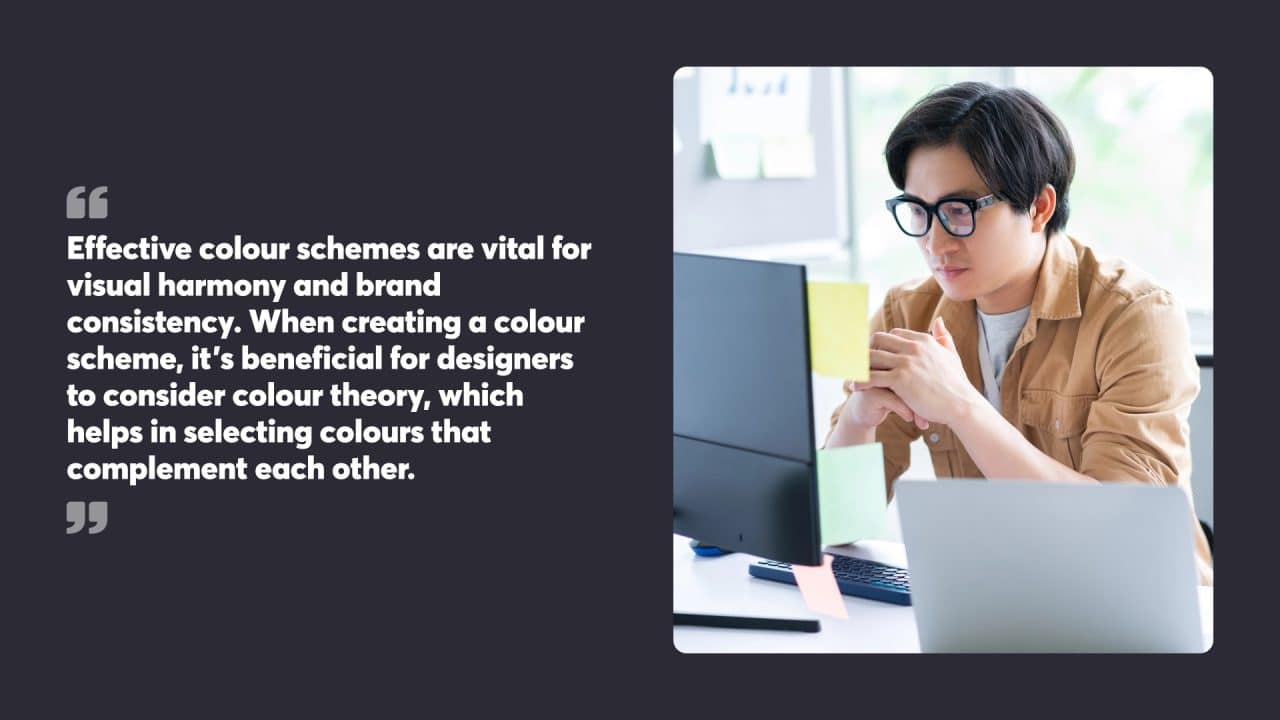
Utilising Colours and Backgrounds
Colours and backgrounds form the cornerstone of design, setting the mood and guiding the visual experience of a website.
Setting Background Properties
In CSS, the background colour property is set on a web page element to specify its background hue. Developers can define background colours using various formats, such as hexadecimal codes, RGB or RGBA values, and colour names. The use of RGBA allows for opacity control, where the ‘alpha’ value dictates transparency, accepting a fraction between 0.0 and 1.0, the latter representing full opacity.
Background images lend visual complexity to a page and are defined with the background-image property. The property can link to an image file that tiles by default. However, with CSS, we can control this tiling behaviour with the background-repeat property, specifying if and how an image repeats across an element.
Creating Colour Schemes
Effective colour schemes are vital for visual harmony and brand consistency. When creating a colour scheme, it’s beneficial for designers to consider colour theory, which helps in selecting colours that complement each other. Tools like colour wheels can aid in finding analogous or contrasting shades that work well together.
To maintain a coherent look, one might use the same colour in different areas of a site, like the navigation and the footer, but with varying shades, tints, or transparencies. Coordinating different elements with a consistent hue can tie the design together without appearing monotonous. The goal is balance – a clever mix of repetition and contrast to captivate and not overwhelm the visitor.

Responsive Web Design Strategies
Responsive web design enables web pages to render well on a variety of devices and screen sizes by using fluid grids, flexible images, and CSS media queries.
Media Queries for Different Devices
Media queries are a CSS technique used to apply styles to web pages based on the characteristics of the device the site is being displayed on, primarily the width of the browser. The syntax for a media query may look something like this:
@media screen and (min-width: 600px) {
.example {
background-color: blue;
}
}The above CSS will apply a blue background colour to elements with the class .example only when the browser window is wider than 600 pixels. Media queries can also target different types of devices such as tablets or printers. They form the backbone of responsive design by allowing multiple web pages to adapt to various display environments.
Scalable Layouts and Text
The structure of responsive web pages is also determined by scalable and fluid grids that use percentages rather than fixed units like pixels for defining the size and spacing of page elements. This allows elements to scale proportionally, accommodating the screen on which the content is being viewed. An example of a fluid grid implementation in CSS might look as follows:
.container {
width: 100%;
max-width: 1200px;
margin: auto;
}
.column {
float: left;
width: 33.33%;
}This CSS code defines a container that is centred and has a maximum width, with its content divided into three columns that each take up one-third of the container’s width. In addition to the layout, text size can be made scalable by using units like em or rem, which are relative to the parent element’s font size or the root element’s font size, respectively, ensuring that the text size changes in relation to the size of the container it’s in. Thus, styling web pages with relative units contributes to the adaptability of content on different devices.
Advanced CSS Techniques
Exploring advanced CSS techniques provides developers with tools for creating more sophisticated visuals and interactions. These methods can bring web designs to life with motion and more complex selection criteria for styling elements.
Transforms and Animation
Transforms in CSS allow elements to be rotated, scaled, translated, or skewed. They are used to alter the appearance and position of elements on a web page without affecting the layout of surrounding content. The transform property accepts multiple functions that can be combined to achieve desired effects, such as rotate(), scale(), translateX(), and skewY().
Animations in CSS breathe life into web pages by enabling transitions between styles over time. To create an animation, we define keyframes using the @keyframes rule, which specifies the styles at various points throughout the animation timeline. By linking these keyframes to an element with the animation property, developers can control the duration, timing, and repetition of animations, amongst other parameters. This encourages more dynamic interactions and visual engagement on web pages.
Advanced Selectors and Pseudo-Classes
CSS selectors have evolved to offer sophisticated means of targeting elements. Beyond basic selectors like class, id, and tag names, advanced selectors enable precise styling based on specific conditions. The nth-child() and nth-of-type() selectors, for example, select elements based on their order in a group, whereas attribute selectors apply styles to elements with certain attributes or attribute values.
Pseudo-classes are utilised to define special states of elements. For instance, :hover applies styles when a user’s pointer is over an element and :focus when an element gains focus. The :not() pseudo-class excludes particular elements from being selected, and :first-child and :last-child target the first and last element in a group, respectively. These allow for interactive and context-specific style rules that adapt to user interactions and document structure.
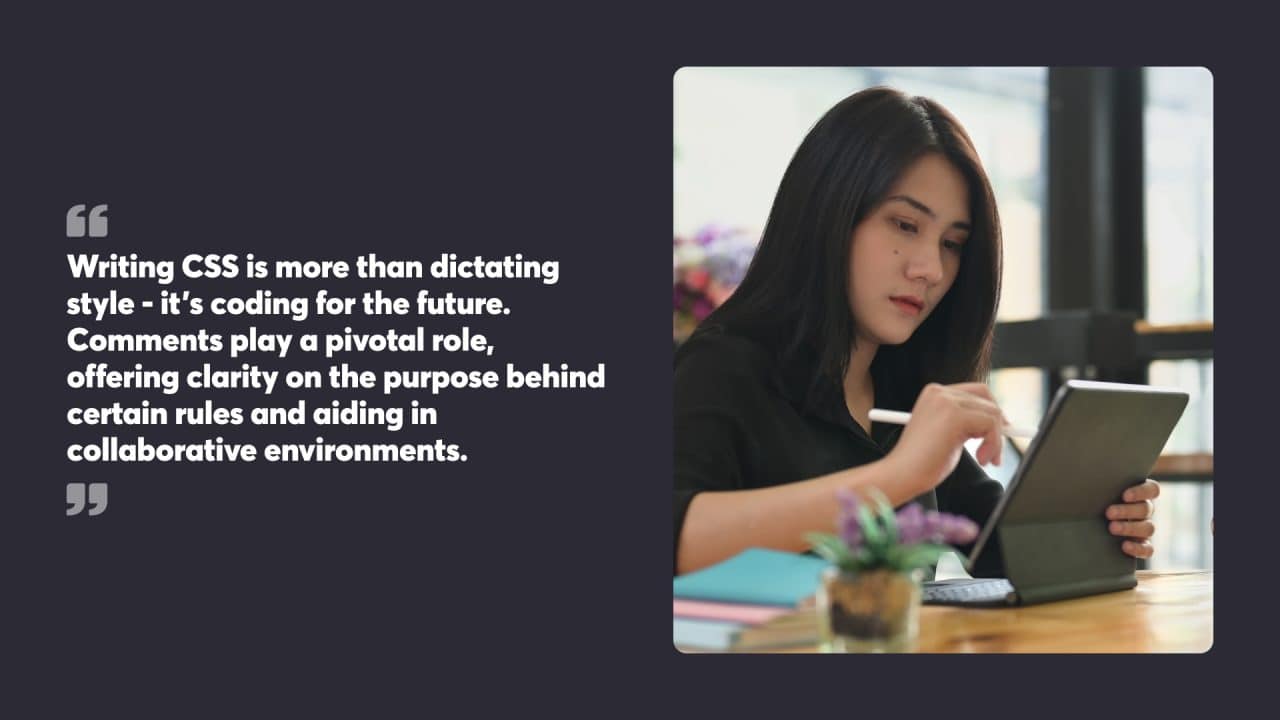
Best Practices for Writing and Maintaining CSS
Writing CSS that styles HTML effectively requires a comprehension of several key practices. Proper documentation, thoughtful organisation, and rigorous testing form the foundation of maintainable CSS strategies in web development.
Commenting and Documenting Your CSS
Writing CSS is more than dictating style – it’s coding for the future. Comments play a pivotal role, offering clarity on the purpose behind certain rules and aiding in collaborative environments. To document CSS efficiently:
- Use comments to explain sections, tricky declarations, or why a particular approach was chosen.
- Keep documentation current with code changes to prevent discrepancies.
- Include information on browser support if using cutting-edge features.
Organisation and Structure of CSS Code
An organised CSS codebase ensures developers can find and edit styles swiftly. Best practices include:
- Maintain a main CSS file that might reference others if needed.
- Group related styles together, such as typography, layout, or components.
- Keep CSS files in the same folder for easier reference.
Testing and Debugging CSS
Validating and refining CSS ensures styles render as intended across various devices and browsers. Steps to test and debug effectively include:
- Test early and often during development to catch issues.
- Use browser developer tools to inspect and modify CSS rules in real time.
- Employ CSS validation services to identify and resolve errors.

Applying Your CSS Skills
Mastering CSS paves the way to styling HTML documents and allows the creation of visually appealing websites. Essential practices include constructing a simple webpage, incorporating CSS into live projects, and identifying subsequent skills to enhance web development proficiency.
Building Your First Web Page
When starting with CSS, the first action is to develop a basic webpage. This initial step involves learning the structure of an HTML document. Most documents begin with a <!DOCTYPE html> declaration, followed by a <html> element that contains <head> and <body> sections.
HTML Structure
<!DOCTYPE html>: Defines document type<html>: Wraps all content<head>: Contains meta-information<body>: Holds the content seen on the page
After structuring HTML, applying CSS to style elements is necessary. This can be done either internally using <style> tags within the <head> section, linking to an external CSS file using the <link> tag, or inline by using the style attribute directly on HTML elements. For instance, to modify the colour and font size of a paragraph, you’d use:
CSS Example
p {
color: blue;
font-size: 16px;
}Integrating CSS with Web Projects
For real-world applications, CSS becomes more complex as it needs to interact with various HTML elements across multiple pages. It’s essential to learn how to add CSS to ensure consistency and maintainability of a site’s design. Common methods include:
- External Stylesheets (
<link rel="stylesheet" href="style.css">) - Internal Stylesheets (within
<style>in the<head>) - Inline Styles (using style attribute in HTML tags)
Effective CSS application means understanding selectors, properties, and values to effectively control the layout and design of multiple elements. This is achieved through classes, IDs, and tags which help apply styles across different sections of the webpage.
What to Learn Next in Web Development
After grasping the basics of a CSS-enabled website, exploring areas such as responsive design, CSS frameworks, and preprocessors is vital for skill advancement. Responsiveness ensures websites function well on devices of all sizes, frameworks provide predefined styles and components to speed up development, and preprocessors like Sass offer advanced features such as variables and nesting to write more concise and manageable codes. Engaging with community forums, reading blog posts on CSS updates, and practising with varied website projects contribute to continuous learning in web development.
If you have any questions about how Chillybin uses CSS in website development, make sure you contact us today.
For developers, keep an eye on our careers page for new opportunities.




